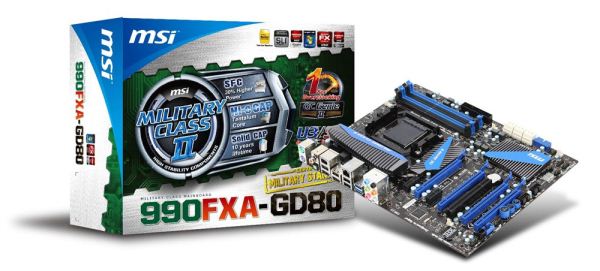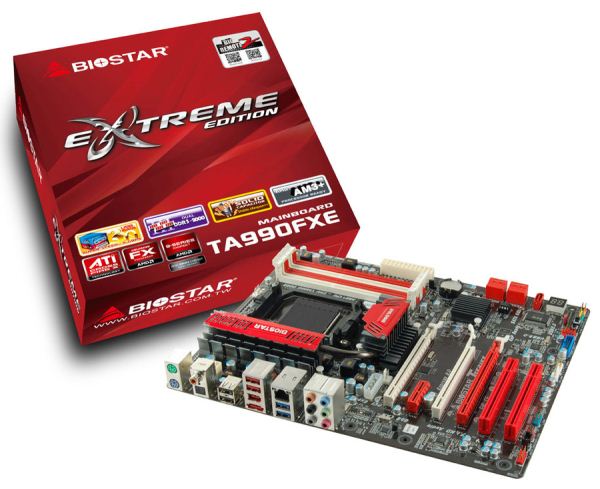990FX Motherboard Roundup with Thuban and Bulldozer – A Second Wind for ASUS, Gigabyte, MSI and Biostar
by Ian Cutress on April 5, 2012 11:00 AM ESTMSI 990FXA-GD80
When considering the MSI 990FXA-GD80 as a product to purchase, it comes with its highs and its lows. On the bright side, we have a good performing system that comes with a mountain of extras in the box compared to other products, and the BIOS is a great system. However, it becomes slightly negative if you want to overclock a Bulldozer, or want any distinct control over the fans.
Users should update their launch BIOSes to F5 or later to take advantage of that new BIOS system, and flashing the BIOS is very simple through the Live Update 5 software provided. Unfortunately the BIOS does not show the user what is auto for voltages, so a little insight is needed when changing these options. There was also a minor problem with my AMD 5850 graphics cards, spinning up to 100% for a few seconds after boot, but this did not happen with my NVIDIA 580 test cards.
Performance wise, nothing stuck out like a sore thumb and the MSI 990FXA-GD80 kept up in pace with the other products we have tested.
For $195, and the bonus in the box, the MSI 990FXA-GD80 is a nice board to run at stock, or a good one to have with a Thuban based processor.
Biostar TA990FXE
As the cheapest board in our test, it was fair to assume that perhaps the TA990FXE would not amount to much when in came to a direct comparison with the other boards in this review - with $50-$100 difference, it was to be expected. On some levels of testing, it shows - the layout isn't optimal, the DPC Latency is hideous compared to the other boards, there are not many fan headers and there is an odd choice of network controller.
However, the Biostar TA990FXE came across as pleasantly surprising. The BIOS works well (even if the options are sometimes in confusing places), it overclocks Bulldozer on par or better than some of the other boards and comes with more kit in the box than expected.
Performance wise it doesn't break into the top half much when discussing CPU benchmarks, however it has a relatively decent showing in the GPU benchmarks. Essentially, this is a board for people who just need something cheap to run their processor. It fits that niche quite well, especially if you only have one GPU and need a PCI slot or two.
While the Biostar TA990FXE isn't the best board in the world, and it could use a little insight and design change to be consumer optimal, it is a cheap board that works.
Conclusion
This combination review has been a long time coming, repetitively pushed back by other releases or events. However we have now crossed through the land of 990FX, examining boards ranging from $130 to $215, and there is a lot to choose from.
Each of the boards can be separated by styling, by BIOS function, any by software utilities. As a direct minor evolution of the 8-series for Bulldozer, it does seem amazing that some motherboards really take to Bulldozer like an old friend, while others prefer it left alone running at stock speeds.
Each board can have its own minor flaws; however one major flaw comes across most of the range - about which CPU temperature sensor to believe when it comes to determining fan speeds. Using HWMonitor, on some motherboards it would report ~14ºC at idle and the CPU fan would be slow, and on others it would be around 30ºC, a more realistic number. This all comes down to whether the system will read the onboard CPU temperature, or a different sensor placed on the board specifically for reporting different temperatures.
This aside, each board has its plus points. If I was a gamer, the ASUS ROG Crosshair V Formula would be my major priority - as it was the board AMD prioritized for Bulldozer release, it is tweaked to run as best as it can. For fan control and performance, nothing comes close to the ASUS Sabertooth 990FX. The Gigabyte 990FXA-UD5 took advantage of that alternative CPU temperature reading and reduced my CPU fan to off or almost off at idle, resulting in a near silent system. The MSI 990FXA-GD80 performs well with a Thuban and provides a nifty USB 3.0 bracket in the box. The Biostar TA990FXE represents full sized ATX on a budget with AMD that is easy to update. If I were to take one, money no object, then I would plunge for one of the ASUS boards.












57 Comments
View All Comments
fredisdead - Saturday, April 7, 2012 - link
The design of bulldozer/ interlagos is aimed at the server market, where it has absolutely smoked intel the last few months.That said, these are suspiciously skewed benchmarks. Have a look here for a better representation of how bulldozer really performs.
http://www.phoronix.com/scan.php?page=article&...
It's pretty simple really, AMD used the chip real estate to double the number of cores, vs using it on less, but more powerful cores. Seeing that a single bulldozer core appears to have about 80% of the performance of an intel i5 core, looks like a good trade off. For highly threaded applications, its a complete win, and they are doing it on less advanced geometry.
That said, AMD's main product in the consumer space isn't bulldozer, it's llano, and thats looking like a rather large success too.
Oscarcharliezulu - Saturday, April 7, 2012 - link
Nicely written review Ian, was a pleasure to read. I like to hear subjective impressions as well as the facts and figures.Looking at an upgrade I thought to support AMD this time around. The boards seem very well featured for the price compared to intel (though they are catching up) and provide good sata3 and USB support. The problem is the BD cpu's run hot, slow and old software won't run well on it compared to older thubans.
My question- is AMD looking to provide support for more than 4 dimm sockets so we can run large amounts of ram in the future?
quanta - Tuesday, April 10, 2012 - link
Ironically, the A70M/A75 'Hudson' chips, which are designed for the non-FX CPU, actually has built-in USB 3 support that even SB950 doesn't have! The 9-series is supposed to be the enthusiast choice, how can AMD dropped the ball even BEFORE it can pick it up? Compare to the CPU that AMD has designed and built, the I/O support chip design is simple, yet AMD can't even get USB 3.0 and PCI Express 3 to at least relieving some performance bottleneck. If AMD can't even get the chip set right, there is no way in silicon hell for AMD to keep its dwindling fan base, at ANY price/performance bracket.primonatron - Thursday, April 12, 2012 - link
That audio chip on the ASUS ROG motherboard IS a Realtek one. They just allow the installation of a X-Fi utility on top for sound effects.You can see the realtek drivers are required on the ASUS website, but an X-Fi utility is also provided.
Marketing hogwash. :(
http://www.asus.com/Motherboards/AMD_AM3Plus/Cross...
cocoviper - Thursday, April 19, 2012 - link
I'm not defining $240 as the limit for Enthusiast CPUs, I'm saying AMD doesn't have any CPUs that are competitive above that price-point.What the category is called is semantics. We could break the entire line into 100 different categories and it wouldn't change the fact that AMD doesn't have any consumer CPUs in the top 3/4 of the market.
I wasn't quoting Anand like he what he says is law or something, I was noting AMD's strategy day where getting out of the high end market was discussed.
Don't you believe AMD, and ultimately all of us as consumers are at a disadvantage if AMD's best product is capped at $250 or so, leaving $250-up-to-however much Intel wants to charge all their domain? How would you feel if the Radeon series only had products in the lower 25% of the $0-$700 Videocard market? Does the best Radeon being capped at $175 seem like it would keep Nvidia competitive in performance and price?
cocoviper - Thursday, April 19, 2012 - link
Isn't arguing about what price-point defines enthusiast the very definition of semantics? Why don't we just make all processors enthusiast, regardless of price. There AMD and Intel now both make enthusiast processors.To return to the point, Intel's enthusiast processors are the only ones occupying the top 3/4 of the market in cost to end customers. Cost is determined by the market; what people will and will not buy. This is why AMD just announced a price cut on the 7000 series to account for the Kepler launch. Competitive performance and prices keep all suppliers in the market in check, and the end consumer benefits.
The point is AMD is ceding the top 3/4 of the market, and even if they make $200 "enthusiast" processors, Intel is free to charge whatever they like to people that need or want high-end performance. This is bad for all of us, and lame on AMD's part.
menlg21p - Wednesday, March 20, 2013 - link
I made a mistake of installing network genie, and it doesn't show up in my programs and features. I cannot uninstall this program. There is no option for execution on startup. So it always starts up on boot. And there is nothing in the directories that pertain to uninstall. Also no online-content about this feature. Ugh, MSI, what are you doing? Why did you suggest this "crap" on my driver disk. REALLY?